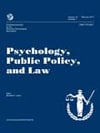
Pretrial publicity in capital cases tends to be highly negative, sensationalistic, and tends to contain prejudicial aspects that can potentially impact the jurors unless the venue is moved – which is rarely done. This is the bottom line of a recently published article in Psychology, Public Policy, and Law. Below is a summary of the research and findings as well as a translation of this research into practice.

Featured Article | Psychology, Public Policy, and Law | 2018, Vol. 24, No. 3, 326–340
The media’s impact on the right to a fair trial: A content analysis of pretrial publicity in capital cases
Authors
Shirin Bakhshay, University of California, Santa Cruz
Craig Haney, University of California, Santa Cruz
Abstract
This study examines whether and how the right to a fair and impartial jury may be compromised by prejudicial news media coverage of death penalty cases. Using a unique data set of historic newspaper coverage of 20 capital cases in California in which defendants filed change of venue motions, we conducted a detailed content analysis of 1,831 newspaper articles to examine the nature and extent of the pretrial publicity in each case. We used a detailed coding scheme with 27 content categories to describe the types of information conveyed; analyze the relative amounts of negative, positive, and neutral content in the publicity; and determine whether the publicity included the kind of information that has been shown to bias prospective jurors. The publicity was overwhelmingly negative and we identified a number of highly prejudicial aspects, including heavy reliance on law enforcement and prosecution sources, numerous instances of sensationalized descriptions of the crime and criminal defendant, and the inclusion of legally excludable material. Despite the potentially biasing effects of the publicity analyzed, venue was rarely changed. Moreover, the trial courts’ decisions appeared largely unrelated to the substantial amount and prejudicial content of the pretrial publicity. Implications for a capital defendant’s right to an impartial jury, due process protections, and the adequacy and availability of effective legal remedies are discussed.
Keywords
pretrial publicity, change of venue, death penalty, content analysis
Summary of the Research
“The Sixth Amendment to the United States Constitution guarantees a criminal defendant the right to “an impartial jury.” This fundamental guarantee is part of a criminal defendant’s basic right to a fair trial, which encompasses the right to be judged by a jury of his or her peers and on the basis of evidence presented at trial. Information that jurors obtained before or outside of the trial itself and any pre-existing, case-related biases they may hold are not supposed to influence their decision-making. In practice, the Sixth Amendment right to an impartial jury has come to mean that jurors cannot have formed opinions about key aspects of the case—and certainly not the defendant’s guilt— before trial. Combined with the “presumption of innocence” that attaches to all criminal defendants at the start of trial, the Sixth Amendment requires jurors to be indifferent, unbiased, and open to the evidence presented at trial. However, in an increasingly media-saturated society, defendants in high profile cases may be tried—and essentially found guilty—by the news media before they reach a courthouse. Depending on the nature and amount of the media coverage that surrounds a particular case, potential jurors may be profoundly affected by what the press reports. As a consequence, criminal defendants may be deprived of basic Sixth Amendment protections.” (p. 326)
“Studies suggest that most people rely on the media as their principle source of information about crime. Moreover, people generally attach a great deal of credibility to news about crime. However, much empirical research has demonstrated that media coverage of crime is often skewed and one-sided. […] Media news coverage of criminal cases may also contain prejudicial information that may be legally inadmissible at trial, but which is disseminated to the public nonetheless. Specifically, certain types of evidence that the court believes will create a danger of “undue prejudice” can be excluded from being presented at trial, including mention of a defendant’s past criminal record, negative statements about a defendant’s character or reputation, prior confessions, and sensationalized or emotionally charged descriptions of the crime. […] There is also some evidence that the media relies very heavily on law enforcement and prosecution sources as the basis for their reporting. […] Because the source of information can influence both its interpretation and the weight it is given, such coverage not only presents just one side of the story but also lends greater legitimacy to the side that law enforcement officials and prosecutors, who are viewed as especially credible sources of information, convey. In combination, these factors can result in an unbalanced and biased media representation of crime, which may threaten a criminal defendant’s right to a fair trial.” (p. 326–327)
“A majority of Americans (over 70%) still follow the news closely and regard traditional news organizations as the largest and most trusted source of news. […] As traditional news media outlets compete for revenue, the tendency to focus on the most sensationalized accounts and cringe-worthy aspects of crime has become more pronounced. Although the idea of promoting the “news as entertainment” is not new, the explosion of online media outlets has added to the fervor and created more options for readers, if anything increasing the potential for biased, sensationalistic coverage to have a correspondingly prejudicial impact.” (p. 327)
“Despite changes in the media landscape, local news sources (both print and online editions) continue to be of significant importance to citizens and potential jurors. […] Local news outlets provide an easier way to access relevant local news without having to sift through the multitude of potentially irrelevant online material. Thus, even in an era of ever-increasing exposure to news and quasi-news stories, local crime coverage continues to be a relevant source of information about local crime.” (p. 327)
“Research has shown that biased news coverage of crime can affect public opinion and may influence the outcome of criminal cases. In specific cases, exposure to media coverage has been shown to have a prejudicial impact on potential jurors’ attitudes toward criminal defendants, including the perceived greater culpability and lessened credibility of the defendant. In some studies exposure to pretrial publicity has resulted in more guilty verdicts and harsher sentences.” (p. 327)
“Concerns over the potentially biasing effects of pretrial publicity are especially pronounced in death penalty cases. […] The fact that death penalty cases generally involve the most severe kinds of violent crimes also means that they tend to receive the most publicity. Such cases often lend themselves to sensationalistic and emotionally charged publicity that portrays the capital defendants as “monsters” and “evil.” […] Moreover, the process of “death qualification,” by which prospective capital jurors are questioned about their views on the death penalty and excluded if they are unwilling to consider the death penalty as an appropriate punishment, may result in the selection of jurors who are especially susceptible to pretrial publicity. […] The nature and amount of pretrial publicity that surrounds a capital case, in particular, can represent a significant threat to the defendant’s fair trial rights.” (p. 327–328)
“Courts have been long aware of the biasing effects that pretrial publicity can have on prospective jurors and the threat that its potentially prejudicial aspects pose to juror impartiality. In fact, a wide range of potential remedies have been established that judges have at their disposal ostensibly to minimize these effects. The remedies include ordering a continuance or delay (postponing the start of the trial until the case-related publicity has subsided); using enhanced or extended voir dire (more extensively questioning prospective jurors about the extent of their publicity-related knowledge about the case and, when the judge deems it necessary, excluding them on the basis of their potential bias); judicial admonitions (instructing jurors simply to disregard or set aside any pretrial publicity they may be aware of and focus only on the evidence presented at trial); and, finally, using jurors from another untainted venue either by importing them from a different county or, much more commonly, changing the venue of the trial itself to a new county that has not been exposed to the pretrial publicity surrounding the case. […] Unfortunately, research suggests that most of these remedies are ineffective and, in some instances, may even exacerbate the prejudice created by pretrial publicity.” (p. 328)
“In light of the limitations of delay, extended voir dire, and the use of judicial admonitions, the only truly effective way to limit or eliminate the potentially prejudicial effects of pretrial publicity is to avoid it altogether—that is, by selecting jurors from a pool of persons who have not been exposed to it. […] Moving a trial to a new venue effectively eliminates publicity-related concerns about pretrial publicity because, instead of attempting the nearly impossible task of curing the bias, it avoids it altogether. […] Despite the fact that moving a trial to a new venue is generally recognized as the most effective way to safeguard against potentially prejudicial pretrial publicity, it is generally believed that venue changes are difficult to obtain.” (p. 328–329)
“The present study focuses on the content of pretrial newspaper publicity associated with a sample of capital cases in California in which changes of venue were sought. Specifically, this study analyzes the publicity files for each case to determine what type of information was contained in the publicity itself, the relative amounts of negative versus positive information, and the extent to which the case-related stories relied on prosecution, law enforcement, or defense-oriented sources. A secondary aim of the study is to preliminarily examine whether the nature and amount of prejudicial pretrial publicity that surrounded the cases appeared to be related to the fate of the change of venue motions themselves (i.e., whether they were granted or denied). Finally, even more preliminarily and tentatively, we report on the final case outcomes—that is, whether the defendant was found guilty and, in those cases where he was, which sentence (life in prison without parole or death) was imposed—when venue was changed and when it was not.” (p. 330)
“This sample consists of the newspaper coverage from a total of 20 California capital cases in which change of venue motions were filed. The cases spanned a 26-year period, from 1979 to 2005, arose in 14 different California counties, and constitute a broad convenience sample of death penalty cases. Although all of the cases were filed capitally (i.e., they were ones in which the prosecution sought the death penalty), they varied considerably in terms of the nature of the crime (e.g., single vs. multiple homicides) as well as the demographic characteristics of the victims and defendants, providing a variety of different case-specific details to analyze. […] The 20 cases in our sample were selected for inclusion based on a number of criteria, including the case facts, procedural posture (i.e., cases in which pretrial change of venue motions were filed), and access to the entire publicity files. […] A total of 1,831 articles were collected across the 20 cases, averaging 92 articles per case, with cases having anywhere between 15 and 381 articles. […] Online forum discussions, such as blogs or Facebook pages, were excluded because they were not published content and could not be systematically reconstructed.” (p. 331)
“The prejudicial content of the extensive pretrial publicity in all 20 cases analyzed in this study was substantial. The publicity relied largely on police and prosecution sources, was overwhelmingly negative and sensationalistic, and included numerous instances of legally excludable information. Very little positive information was present in the pretrial publicity to remotely “balance” the messages conveyed, and almost none of it could be considered mitigating. These were all capital cases where the crimes were, by definition, the most serious, and, as we documented, the publicity extensive and one-sided. Therefore, these were precisely the kinds of cases in which motions to change venue are most typically made and the reasons weighing in favor of moving the trial venue seemingly the most compelling. Despite the fact that the publicity- and case-related factors favored granting a change of venue, as emphasized in pretrial motion hearings where defense attorneys not only argued for the need to move the trial but also typically presented expert consultants who documented the need to do so, judges nonetheless only agreed to change venue in 32% of the cases (six out of 19).” (p. 338)
Translating Research into Practice
“The finding that in none of the cases with the most negative publicity was venue changed suggests a potentially serious judicial bias, one that may threaten the due process rights of capital defendants in high profile cases. Although we are cautious to draw too many conclusions from a single study, our findings suggests that the legal standard that governs change of venue is being interpreted in potentially problematic ways that may deny certain capital defendants their constitutionally mandated fair trial rights. Change of venue is a procedural mechanism designed to give meaning to the right to an impartial jury in cases where it appears to be compromised. Yet this study raises a number of questions about whether and how effectively this mechanism is being implemented, including how many of the defendants in the capital cases included in our sample could truly receive the fair trials to which they were constitutionally entitled.” (p. 338)
“Courts may continue to be reluctant to move trials to new venues, even in the most highly publicized cases, even though moving a trial to a new, untainted venue has been shown to be the only consistently successful means for dealing with the biasing effects of pretrial publicity. This means that legal practitioners will need effective tools with which to argue for venue changes in the appropriate case, including empirical research on the content and impact of prejudicial pretrial publicity on jury bias and trial outcomes as well as a better understanding of the factors and circumstances that persuade judges to move trials.” (p. 339)
“It seems clear that the extreme amount of pretrial publicity that often accompanies a capital case can undermine the defendant’s constitutional right to be tried by an impartial jury. Of course, the potential impact of prejudicial pretrial publicity in a capital case is not only that it may significantly impact jurors’ assessments of the defendant’s guilt but also their culpability and their potential “deathworthiness.” Nonetheless, at least in the sample of cases we analyzed, these risks do not appear to be fully acknowledged or appreciated by the judiciary. Judges instead appeared willing to minimize the deep cognitive and psychological effects that negative pretrial publicity can have on prospective jurors by failing to take the one step that effectively minimizes or eliminates them.” (pp. 338–339)
“Although this study documented the nature and amount of publicity in cases from the largely predigital age, it provides a cautionary tale for the future of crime media and procedural justice. Crime coverage continues to be highly sensationalist, relying on graphic details and headlines to attract readers in an ever-increasingly competitive marketplace. […] To the extent that news organizations and other media outlets reiterate the crime master narrative and focus on sensationalized details to gain readers’ attention, they are arguably helping to undermine the fairness of the jury trial process.” (p. 339)
Other Interesting Tidbits for Researchers and Clinicians
“There were several limitations in our study that are worth noting. First and foremost, as mentioned above, is the small sample of 20 cases. Although our content analysis included a very large number of articles, the total number of cases included was too small to draw any causal conclusions. We hope to further explore this and several other issues raised by this research with a larger national sample of capital cases in which change of venue was sought, allowing us to better examine potential causal mechanisms. Our study is also limited to California cases. Although we have no reason to believe that the types of cases brought in California and the attendant media coverage of those cases differs significantly from the rest of the country, we did not include cases from additional jurisdictions in our sample and cannot speak to the widespread applicability of our findings. Future research on change of venue should include a larger sample of cases from California as well as other jurisdictions to bolster the generalizability of our findings and allow for further investigation of the impact that moving trial venue has on case outcomes.” (p. 338)
“It is also important to note that we did not include TV or radio coverage of the cases in our sample. Although TV news in particular was prominent during the timeframe studied (and remains so today), we were not able to include these sources because there are no reliable archives of this data and so their inclusion would have been incomplete at best. In future studies on this topic, it would be helpful to include an analysis of TV and radio news transcripts.” (p. 338)
“In addition, our data set consisted of capital cases that were mostly tried before the advent of online and social media and so our study did not include an analysis of purely online content concerning local crime. Although many aspects of local crime news coverage remain the same, especially the content of the coverage and its importance to local residents and communities, some aspects of the “new media” environment warrant further study. Future research might examine whether and how social media highlight certain sensational aspects of crime or act as conduits for dissemination and discussion.” (p. 338)
Join the Discussion
As always, please join the discussion below if you have thoughts or comments to add!






















